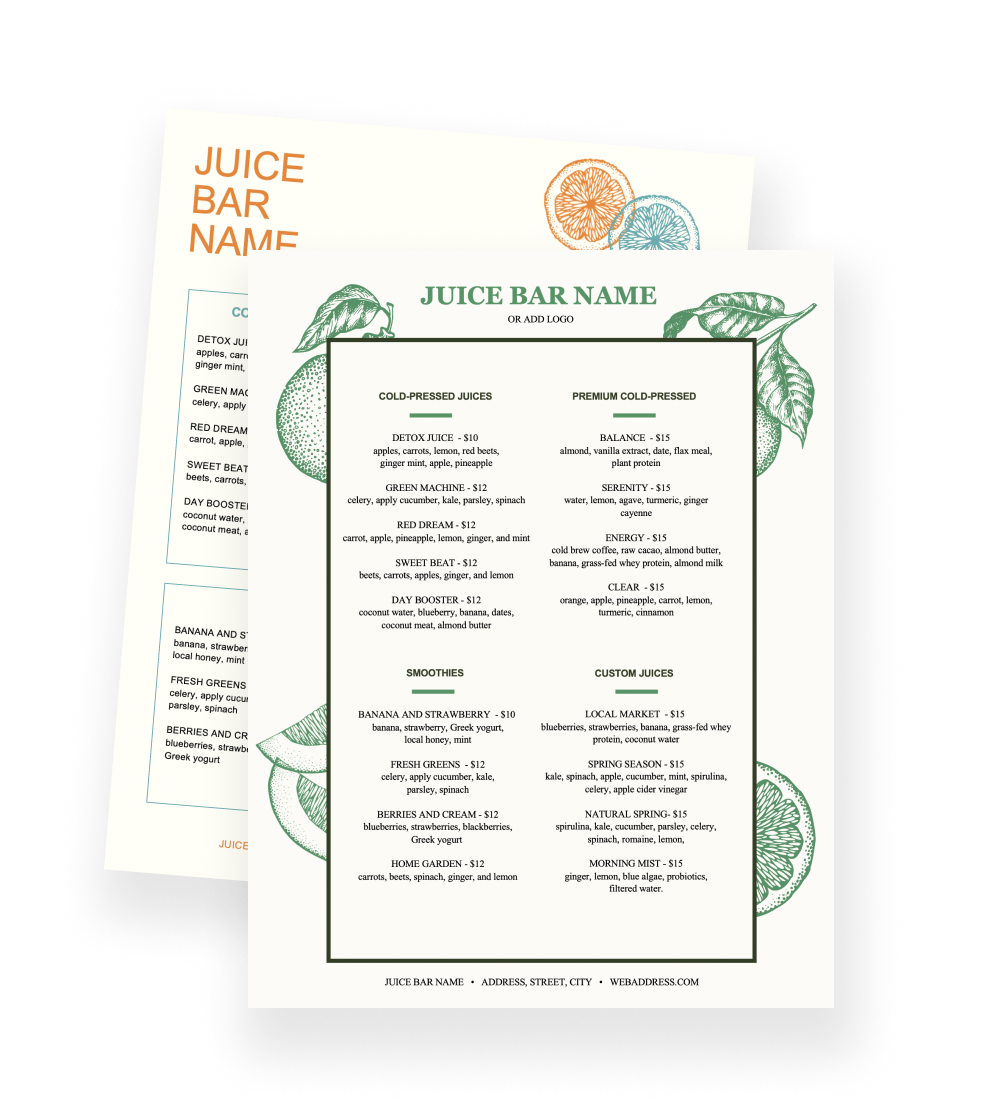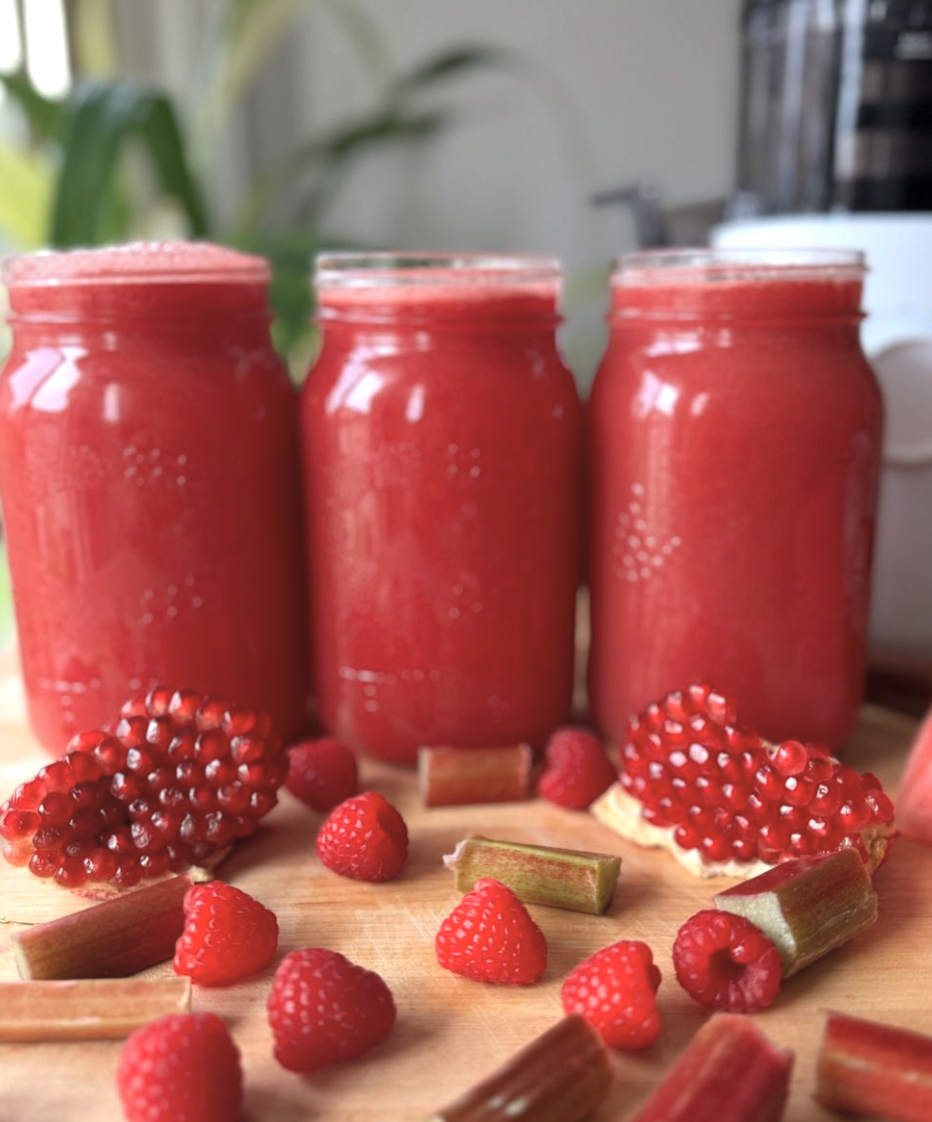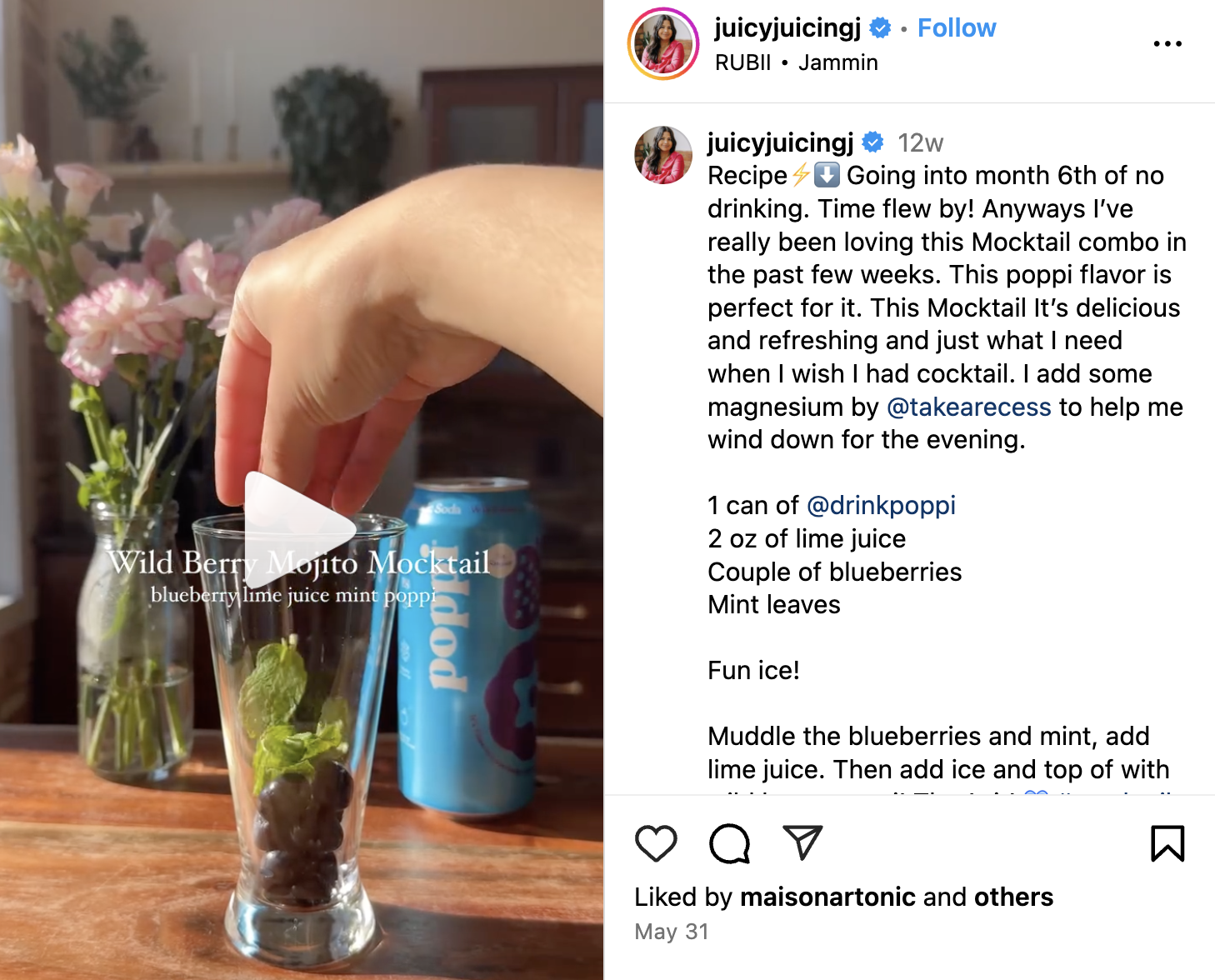
Juice Bar Recipes: How to Develop Juice Bar Recipes [2024]
Here is everything you need to develop your juice bar recipes, from research and development to testing and scaling.
Aidan ToborAuthor


Juice Bar Menu Templates
Use these juice bar menu templates as a starting point for your menu design or to give your menu a refresh.
Get free downloadJuice bars have become a cornerstone of modern health-conscious culinary culture, offering refreshing beverages and a wide array of nutrient-packed concoctions. According to IBISWorld, the revenue of juice and smoothie bars has been rising at a CAGR of 1.9% to $4.0 billion over the past five years, including an expected 0.2% increase in 2024. Driven by increasing global demand and evolving consumer preferences, this growth provides an opportunity for juice bar owners to develop new offerings, attract new customers, and tap into a thriving market.
From classic orange juice to innovative green juice recipes, juice bar offerings have evolved to cater to diverse tastes and health preferences. This guide will help aspiring juice bar owners and health enthusiasts develop standout recipes tailored specifically for a juice bar setting, ensuring both creativity and consistency in their offerings.
Steps to Developing Your Juice Bar Recipes
1. Research and Inspiration
Creating exceptional juice bar recipes begins with thorough research and abundant inspiration.
Explore Juicing Trends and Popular Superfoods
Stay updated on current juicing trends and popular superfoods by subscribing to health and wellness magazines and following nutrition blogs. Explore how these trends can be adapted to juice bar classics. For example, consider incorporating trendy ingredients like turmeric or acai into traditional juice recipes or smoothie recipes.
Develop your own healthy concoctions like this “Gut Health Lemonade” crafted by Juicing Tutorials. This juice elixir is packed with ingredients that support a healthy gut.
Visit Local Juice Bars and Farmers' Markets
Spend time at local juice bars to understand what makes them successful. Observe the best-selling items, customer preferences, and unique twists on traditional recipes. Take note of the presentation, portion sizes, and flavor combinations. Additionally, visit farmers' markets to discover fresh, seasonal produce that can inspire new juice recipes and seasonal specials.
Follow Juicing-Focused Blogs and Social Media Influencers
Follow food blogs and social media influencers who specialize in juicing and smoothie recipes. Platforms like Instagram and Pinterest can provide visual inspiration and highlight emerging trends in juice bar offerings. Look for innovative takes on classic drinks, such as cold-pressed juice variations or green smoothies with unexpected ingredient combinations.
For example, Instagram influencer Ivonka Schellenberg (@juicemadamofficial) frequently posts juice, sorbet, and wellness shot recipes. The photos alone will have you reaching for your juicer!
Attend Health and Wellness Events
Health and wellness events showcase innovative juice and smoothie recipes and provide networking opportunities with nutritionists and health food enthusiasts. Attend these events to gather new ideas and insights into potential menu items for your juice bar. For example, a detox-themed workshop might inspire new green juice recipes or superfood-packed smoothie ideas.
2. Defining Your Juice Bar Concept
A clear and distinct concept is essential for developing a cohesive menu.
Identify Your Target Market and Their Preferences
Determine the demographics of your target market. Are they health-conscious individuals looking for detox options, fitness enthusiasts seeking protein-packed smoothies, or busy professionals looking for quick, nutritious drinks? Understanding your audience will help you tailor your menu to their tastes and preferences.
Choose a Specific Juicing Style or Fusion of Styles
Decide whether your juice bar will focus on traditional fruit juices, vegetable-heavy green juices, or a fusion of styles. For instance, you might blend classic fruit juices with superfood-packed green smoothies, creating a unique menu that offers the best of both worlds.
Determine Your Unique Selling Proposition (USP)
Identify what sets your juice bar apart. This could be a signature juice recipe, house-made nut milks, or a particular ingredient sourcing method. Your USP should resonate with your target market and reflect in your recipes. For example, a juice bar might be known for its cold-pressed juices or locally sourced, organic produce.
Consider Dietary Needs and Preferences
Modern juice bars often cater to various dietary needs. Include vegan, gluten-free, and low-sugar options on your menu to accommodate a broader customer base. Offering a variety of options ensures that all customers feel welcome and can find something they enjoy, whether it's a fruit-packed smoothie or a veggie-heavy green juice.
3. Brainstorming and Initial Recipe Ideas
With your concept in mind, start brainstorming and generating initial recipe ideas.
List Potential Drinks That Fit Your Concept
Create a list of juices and smoothies that align with your juice bar's theme. Think about classic staples like orange juice and apple juice, as well as more innovative concoctions like beet-based detox juices or kiwi-spinach smoothies. Consider how you can put a unique twist on them. For instance, a juice bar focusing on superfoods might offer an "Antioxidant Blast" juice featuring berries, dark leafy greens, and a hint of fresh ginger.
Known for delicious superfood smoothies, organic juices, and plant-based meals, Austin-bred JuiceLand is committed to bringing fresh, friendly, and authentic service to the community. When asked about his favorite ‘feel-better’ drink, founder and CEO Matt Shook told Perfect Day, “One of our past Feel Good, Do Good specials stands out to me. The ‘Super Fun Guy’ smoothie has mango, turmeric, and cold-pressed pineapple & orange juice, along with coconut oil, mood-enhancing superfood mushrooms, and spirulina. I’ll make it even more fun by adding CBD oil. I call that one a ‘Super Fun Guy and a Pretty Chill Dude.’ Plus, our Feel Good, Do Good monthly specials give proceeds to selected local charities to which we’ve donated around $80,000 to date and growing!”
Consider Seasonal Ingredients and Local Produce
Incorporate seasonal ingredients and local produce to ensure freshness and support local farmers. This approach can also inspire seasonal specials that keep your menu exciting. For example, a summer menu might feature watermelon-based juices and tropical smoothies, while a fall menu could highlight pumpkin and apple juice combinations.
Think About Menu Diversity
A well-rounded juice bar menu should include a variety of options, including fruit juices, vegetable juices, smoothies, and potentially some healthy snacks or light meals. This diversity caters to different tastes and keeps your offerings appealing throughout the day. Ensure that you have options for different occasions, such as energizing morning juices and more indulgent afternoon smoothie treats.
4. Recipe Development Process
Developing recipes involves a detailed and iterative process.
Start with Basic Versions of Each Drink
Begin with simple, basic versions of your juices and smoothies. Focus on nailing the fundamental flavors and nutritional profiles before experimenting with more complex variations. For example, start with a classic green juice recipe before adding unique ingredients like pineapple or coconut water.
Experiment with Different Ingredients and Juicing Techniques
Test different ingredients and juicing techniques to enhance your recipes. For example, try various types of leafy greens for your green juices, or different ratios of fruits to vegetables in your smoothies. Experiment with juicing methods like cold-pressing or high-speed blending to find the best approach for each drink.
Focus on Balancing Flavors, Nutritional Value, and Visual Appeal
Strive for a balance of flavors (sweet, tart, earthy), nutritional value (vitamins, minerals, antioxidants), and visual appeal (color, texture, garnish). A visually appealing juice or smoothie with a well-rounded taste profile and high nutritional value will leave a lasting impression. For instance, a vibrant purple smoothie bowl topped with chia seeds, sliced kiwi, and a drizzle of almond butter offers a satisfying mix of flavors, textures, and nutrients.
Or even create your own healthy adult beverage alternatives like this “Wild Berry Mojito Mocktail” shared by author and digital creator Jeanette Velasco Shane.
Opening a Juice Bar Checklist
So many things go into opening a juice bar. With this free PDF checklist, you'll set your new business up for success.

Keep Portion Sizes and Pricing in Mind
Ensure your portion sizes are appropriate for a juice bar setting and your pricing is competitive. Juice bars often offer various size options to cater to different customer needs. Analyze your costs and set prices that ensure profitability while providing value to customers.
5. Testing and Refining Recipes
Testing and refining your recipes ensures they meet high standards.
Conduct Taste Tests with Friends, Family, and Potential Customers
Invite friends, family, and potential customers to taste your juices and smoothies. Their feedback can provide valuable insights into what works and what needs improvement. Create a feedback form to gather specific comments on flavor, texture, sweetness level, and overall satisfaction.
Gather Feedback on Flavor, Nutritional Value, and Overall Appeal
Collect detailed feedback on the flavor, nutritional value, and overall appeal of each item. This information is essential for making necessary adjustments. Pay attention to recurring comments and be willing to make changes based on the feedback received.
Make Adjustments Based on Feedback and Retest
Use the feedback to refine your recipes and retest them. This iterative process helps achieve the perfect balance of taste and nutritional value. For example, if testers find a green juice too bitter, adjust the ratio of fruits to vegetables and retest until it reaches the desired flavor profile.
Ensure Consistency in Taste and Quality
Consistency is key to building a loyal customer base. Ensure every batch of your juices and smoothies meets the same high standards. Develop standardized recipes and train your staff to follow them precisely, ensuring that each drink is prepared and presented consistently.
6. Sourcing Ingredients
High-quality ingredients are the backbone of great juice bar recipes.
Find Reliable Suppliers for Fresh and High-Quality Produce
Establish relationships with reliable suppliers who can provide fresh and high-quality produce consistently. Look for suppliers who share your commitment to quality and can deliver on time. This is particularly important for key ingredients like leafy greens, fruits, and superfoods.
Build Relationships with Local Farmers and Markets
Supporting local farmers and markets not only ensures fresh produce but also fosters community connections and sustainability. Attend farmers' markets and build relationships with local producers to source the best ingredients for your juices and smoothies. This can be especially beneficial for seasonal ingredients like berries or specialty greens.
Consider Cost-Effective Options Without Compromising Quality
While quality is paramount, it's important to find cost-effective options. Bulk purchasing and negotiating with suppliers can help manage costs. Consider working with multiple suppliers to find the best prices without compromising on quality. For example, you might source your staple fruits and vegetables from one supplier and your specialty superfoods from another to ensure the best quality-to-price ratio.
Plan for Ingredient Availability and Seasonality
Plan your menu around the availability and seasonality of ingredients to maintain quality and keep costs manageable. Create a seasonal menu that highlights the freshest ingredients available, ensuring your juices and smoothies are always at their best. This might include offering a fresh strawberry-basil lemonade only during peak strawberry season or featuring a pumpkin spice smoothie in the fall.
Certified Nutritional Therapist and founder of Green Kitchen Stories, Luise Vindahl, shared her favorite seasonal cold-pressed “Green Garden Juice” recipe. The blend of crisp fruits and veggies is like a salad in your cup!
7. Scaling Recipes for a Juice Bar
Scaling recipes for a juice bar setting requires careful planning.
Adjust Recipe Quantities for Larger Batches
Modify your recipes to accommodate larger batch sizes, ensuring the taste and quality remain consistent. Use precise measurements and scaling techniques to maintain the integrity of each juice or smoothie. This is particularly important for pre-made bases or popular drinks that are prepared in larger quantities.
Here are some batch juicing tips shared by documentary filmmaker and wellness advocate Joe Cross.
Ensure Consistency in Taste and Presentation for Every Serving
Develop a standardized process for preparing and serving each drink to maintain consistency in taste and presentation. Create detailed recipe cards and training materials for your staff to follow. This might include specific instructions on how to properly measure ingredients, blend smoothies, and garnish drinks.
Develop a System for Efficient Prep and Juicing in the Juice Bar
Create an efficient prep and juicing system that allows for quick service without compromising quality. This might include pre-washing and cutting fruits and vegetables, organizing your kitchen layout for optimal workflow, and streamlining juicing processes to handle peak times effectively. For example, you might prepare certain juice bases in advance and store them properly for quick assembly during busy periods.
Consider Storage and Display Limitations in the Juice Bar
Be mindful of storage and display limitations. Optimize your kitchen layout and refrigeration units to ensure smooth operations and appealing presentation. Invest in proper storage equipment and organize your ingredients to maximize efficiency. This might include using clear, labeled containers for pre-cut produce and investing in attractive display cases or menu boards to showcase your creations.
Energize Your Juice Bar Recipes
Developing juice bar recipes is an art that combines creativity, nutritional knowledge, and business acumen. By following this comprehensive guide, you can create a menu of delicious, innovative juices and smoothies that will delight your customers and set your establishment apart. Remember that the key to success lies in continuous improvement and adaptation to customer preferences and health trends. With dedication and attention to detail, your juice bar recipes can become the cornerstone of a thriving business, offering memorable flavors and health benefits to satisfy every customer who walks through your door.
Related Resources
Is this article helpful?
DISCLAIMER: This information is provided for general informational purposes only, and publication does not constitute an endorsement. Toast does not warrant the accuracy or completeness of any information, text, graphics, links, or other items contained within this content. Toast does not guarantee you will achieve any specific results if you follow any advice herein. It may be advisable for you to consult with a professional such as a lawyer, accountant, or business advisor for advice specific to your situation.
Read More
Subscribe to On the Line
Sign up to get industry intel, advice, tools, and honest takes from real people tackling their restaurants’ greatest challenges.







